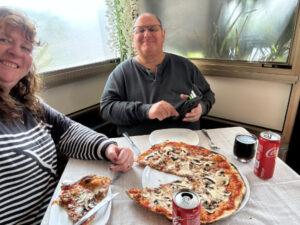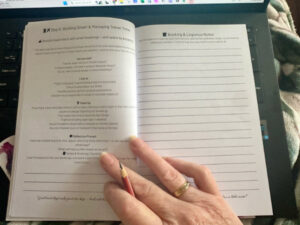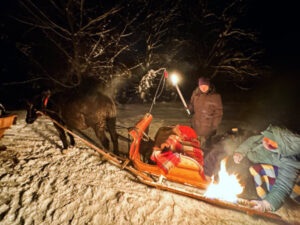Planning a holiday together can be one of the most rewarding — and revealing — experiences a couple shares. But many people return home disappointed, not because the destination was wrong, but because stress, unmet expectations, or a lack of shared vision got in the way.
This guide offers seven practical steps to help you plan a travel itinerary that’s meaningful and intentional — one that not only shapes a great trip but strengthens your relationship along the way.
Whether you’re a flexible sketch-it-out kind of traveller or someone who finds peace in planning every detail, these steps will help you get on the same page and build something beautiful together.
Step 1: Embrace the Joy of the Journey
Why planning a travel itinerary should be part of the fun
Planning a holiday should be a joyous experience. It’s the perfect opportunity to start the fun from the moment you say, “Let’s start dreaming.”
Remember, when you plan a travel itinerary, it doesn’t have to be a chore. You can make it fun and use it as a guide, not a script. Once your itinerary is sorted, the real fun can begin as you focus on the exciting activities and beautiful places you’ll explore.
You’re about to plan a fantastic holiday, so why not make a celebration out of the process? With your chosen travel partner, plan your planning party—set up a cheese board, toast your plans with wine or beer, and theme it to your destination.
Couples’ Tip: This isn’t just about travel. It’s a moment to check in, laugh together, and enjoy building something side by side.

Dream with abandon
Step 2: Start Dreaming Big
How to plan a travel itinerary by first listing your dream destinations
Without the restriction of reality, list the places you would love to go and how much time you would want to spend in each. This step is about inspiration and hope, not cost or limitations.
Think big. Four nights in Paris, two nights in Arles, a few in Venice, and several days finishing in Rome. Or maybe an outback road trip, a loop through New Zealand, or a string of coastal towns with nothing but time.
Once you’ve made your dream list, tally the number of days it would take. This is your first real picture of your ideal itinerary — and the starting point to plan a travel itinerary that excites you.

When reality and dreaming don’t fit
Example: Final Trimmed Itinerary
After removing a few places and giving yourself breathing room, here’s a more realistic plan — and it still looks fantastic.

Still covers a lot of Ground.
Step 3: Get Real (But Don’t Get Discouraged)
Balancing time, budget, and expectations when you plan a travel itinerary
Now it’s time to see how your dreams match reality. Look at:
How much time can you both take off work
How much time will you lose in transit (e.g., 3–4 days just flying from Australia to Europe)
Budget expectations and limitations
Let’s say you dreamed up a 35-day trip, but you only have 21 days of leave. You’ll likely need to trim. And that’s okay — it’s part of learning how to plan a travel itinerary you can take.
Budgeting Together for a Realistic Itinerary
Next, bring in the budget conversation. It’s essential to make sure both of you are on the same page. We typically work with a daily budget of AUD350 for land costs and AUD 4,500 – $5,00 for return flights. We also add AUD 3000 for transport and extras, which covers larger expenses such as car rentals, trains, buses, and short flights.
But this is just a starting point. Think about:
Your travel style (budget-conscious, mid-range comfort, or luxury?)
Exchange rates and how they impact your daily expenses
What experiences would you rather splurge on (accommodation, food, tours)?
What you can comfortably save in advance
A simple spreadsheet can help here. Map out your top destinations and give each one a rough per-day cost. Don’t forget to include:
Accommodation (nightly estimate x number of nights)
Transport (flights, trains, buses, rental cars)
Food and drink (per day)
Entry fees, tours, or splurge activities
Travel insurance and contingencies
Now look again at your dream list. Are there similar destinations? (For example: Amalfi Coast and Cinque Terre.) Pick one and save the other for another trip. Cut the excess without losing the essence.
Real Talk: This step can feel like a downer, but it’s not. It’s where your dream starts taking shape as a real, achievable plan.
Lunch in Civitavecchia.
Step 4: Balance Big Cities with Slower Stops

Finding your perfect travel pace for a well-rounded itinerary
Cities offer culture, architecture, and energy—but they also bring noise, crowds, and decision fatigue. Villages give you a slower pace, ease, and unexpected encounters with locals. We’ve learned to be intentional about mixing both.
Example: You’ve chosen France, Italy, and a quick dash to Scotland. But Scotland is a flight away from the other two. It may mean losing precious time in transit. In that case, we’d recommend narrowing your focus to just France and Italy. Keep regions close. It will simplify your logistics and leave more time for joy.
Personal Lesson: We once crammed so much into a trip that we came home exhausted. The photos were beautiful, but the memories were foggy. Leave space to breathe.
Planning Question: What’s your ideal rhythm? A few days of fast-paced city exploring followed by a quiet retreat? Build in that rhythm early.
Planning Tip: If two places are similar (e.g., Amalfi Coast vs. Cinque Terre), choose just one. You can always go back another time.

Corner house Upper Town, Chartres
Step 5: Turn Your Ideas into a Practical Plan
How to map out nights, routes, and bookings when you plan a travel itinerary
This is the moment when the vision becomes a structure.
How many nights in each spot?
What’s your logical route from one place to the next?
Do you need an open-jaw flight (arrive in one city, depart from another)?
When you plan a travel itinerary, mapping the basic flow is your trip’s skeleton. From here, you can begin booking accommodation, travel passes, and any must-do experiences.
If your plan includes multiple countries, take note of border crossings, currency changes, and SIM card needs. We also recommend keeping a paper copy of your bookings—it’s handy when your phone’s dead or you don’t have Wi-Fi.
Pro Tip: If this part overwhelms you, break it into 15-minute blocks. One city at a time. One mode of transport. It adds up fast.
Step 6: Consider the Timing and Season
Why seasonality matters when you plan a travel itinerary
Research average weather, significant events, and crowd levels. Shoulder seasons (like spring and autumn in Europe) often offer the best of both worlds — lighter crowds and pleasant weather.
Summer brings energy and longer days, but also heat and crowds. Winter can be magical in the right places (hello, Christmas markets), but comes with shorter days and colder weather.
Thinking about seasonality is essential if you want to plan a travel itinerary that matches your expectations, whether that’s summer energy, winter charm, or spring blossoms.

Step 7: Add Meaningful Moments
Planning connection, not just activities, into your travel itinerary
Don’t just plan what you’ll do—think about why you’re doing it.
Build in time for what fills your cup. That might be:
A long lunch in a vineyard
A street market wander with no agenda
A spontaneous detour to somewhere you found on a local signpost
Also, plan for connection. Maybe you’ll:
Start each day with a quiet coffee and journal
End each night with a thankful reflection
Trade off planning days to surprise each other
A truly great way to plan a travel itinerary is to build in time for connection: a long lunch in a vineyard, a market wander with no agenda, or a quiet morning coffee together before heading out.
Relational Insight: Travel brings out the best and worst in us. How we face unexpected moments can strengthen or strain a relationship. Planning with intention now gives you a better chance to thrive in the moment.
Prompt: What kind of memories do you want to bring home—not just photos, but feelings?

Sleigh ride Zakopane
Step 8: Enjoy the Planning Process
Making the process of planning a travel itinerary part of the adventure
Yes, planning can feel like a lot… but it’s also part of the adventure.
You’ll learn so much before you even board the plane. You’ll picture your days, anticipate your mornings, and feel that slow build of excitement.
Make space to dream, and enjoy those moments where the possibilities start to feel real. This is where your trip becomes uniquely yours.
Bonus Step: Pack with Purpose

My bags
Packing for the trip you’ve planned — not every “what if” scenario
Packing can be stressful or freeing. If you’ve followed the steps above to plan your travel itinerary, you already know what you’ll be doing — so you can pack accordingly.
Choose layers that mix and match.
Pack for the activities you’ve planned (not everything you might do)
Leave space in your bag—and your plans—for what you’ll discover along the way.
We also prep a travel folder with our full itinerary, emergency contacts, key phrases in the local language, and a few reflection prompts. It helps us stay grounded and present.
Couples’ Tip: Packing light is an act of kindness to your future selves. Lugging heavy bags up metro stairs isn’t romantic.
Free Download: Your Planning Worksheet
To help you take action on these steps, we’ve created a simple printable PDF that walks you through the process.
Click here to download your free worksheet.
It’s a gentle guide to keep your plans clear and realistic — one step at a time.
✨ Want a Travel Companion That Brings It All Together?
We’ve also designed the Sapphire Blue Travel Journal — a practical, beautifully designed travel companion that includes:
A planning section that matches these steps
Daily space to journal your journey
Packing review pages to reflect and improve for next time
It’s more than a notebook — it’s a travel keepsake and planning tool in one. Perfect for couples who want to travel intentionally.

Our Travel Journal Cover
View the journal here on Amazon (AU)
Final Thoughts
Travel doesn’t have to be flashy or far away — it could be a cosy night in a cottage, a weekend drive, or a simple day trip. What matters most is the intention behind it and the person beside you. We hope and pray these steps help you plan a travel itinerary that builds connection, eases stress, and creates memories worth treasuring. Remember, it doesn’t have to be perfect to be wonderful — take the first step and enjoy the journey.



